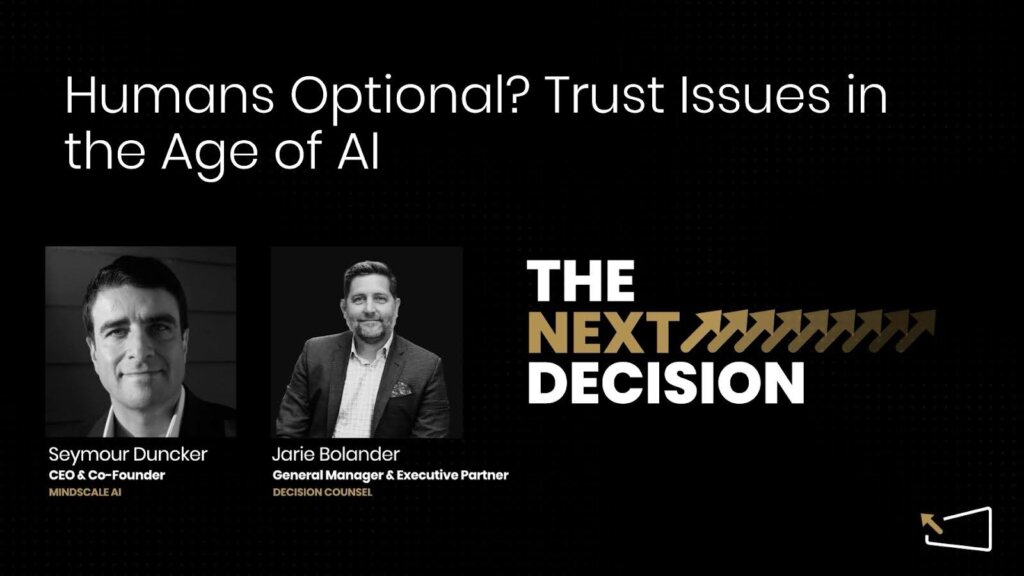From The Next Decision Podcast: A Conversation with Seymour Duncker, Executive Strategist at Decision Council and Founder of MindScale AI
“If you remove humans from decision-making, you remove accountability.”
That’s the central insight from Seymour Duncker in this episode of The Next Decision, hosted by Jarie Bolander. In a world rushing to automate everything, Seymour pulls back the curtain on the risks, gaps, and blind spots of AI adoption—especially when trust is treated as an afterthought.
In this recap, we’ll unpack the episode’s core takeaways: what happens when human oversight disappears, how to build systems that earn trust, and what executives must understand before AI becomes just another black box.
Automation ≠ Intelligence
Seymour doesn’t mince words. Just because AI can replace a decision doesn’t mean it should.
“Too often, AI is treated like a magic wand. But without transparency, you’re just scaling uncertainty.”
He argues that real intelligence isn’t about speed or complexity—it’s about accountability. And when humans are removed from the loop, so is the ability to understand or challenge outcomes.
The Real Trust Problem
Trust in AI isn’t just a UX issue—it’s an existential one.
In many organizations, AI gets greenlit for efficiency, not trustworthiness. Seymour shares hard truths about what happens when models act without context or ethical grounding: eroded confidence, legal exposure, and customer fallout.
“There’s a difference between a tool that supports decisions and one that makes them. Leaders need to know where that line is.”
Explainability Is the New UX
Forget glossy dashboards. Seymour emphasizes that explainability is no longer a nice-to-have—it’s essential for adoption, compliance, and long-term success.
That means designing AI systems that show their work. Not just the what, but the why behind a decision.
“Executives shouldn’t need a PhD to trust their own systems. They need transparency built in from day one.”
Don’t Scale Chaos
One of the episode’s sharpest moments is a warning: if your AI isn’t aligned with your business goals, values, and ethics, all you’re doing is scaling chaos.
Seymour recommends a framework grounded in alignment—between teams, data, and mission. That includes:
- Human-in-the-loop systems
- Cross-functional risk reviews
- Clear OKRs that link model outputs to real outcomes
Tech Follows Strategy
As Jarie puts it: “Tech moves fast. But leadership defines direction.”
Seymour echoes that sentiment. He calls for executive-level engagement in AI—not just to fund it, but to shape its purpose. Without leadership guiding the conversation, AI becomes a runaway experiment rather than a strategic asset.
The Takeaway: Trust Is the Hard Part
AI isn’t a plug-and-play solution. It’s a complex system that needs governance, guardrails, and human sense-making.
“Trust is earned. And in AI, it’s built or broken every time the system makes a decision.”
For organizations adopting AI, this episode is your signal: don’t just chase performance. Build for clarity, accountability, and alignment—or risk losing the very trust that makes AI useful in the first place.
Listen to the Episode
Catch the full conversation with Seymour Duncker in Episode 3 of The Next Decision: “Humans Optional? Trust Issues in the Age of AI”
Available on Spotify, YouTube, and wherever you get your shows.
Final Thought
If you’re a founder, strategist, or executive exploring AI, don’t skip the hard part.
Trust isn’t a deliverable. It’s a design choice.
Make the right one.



